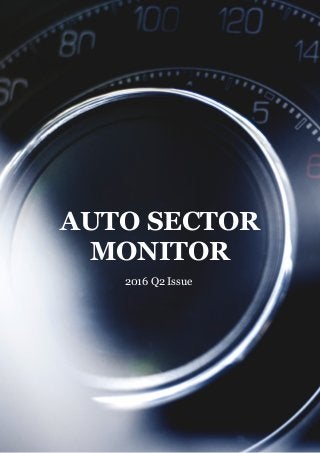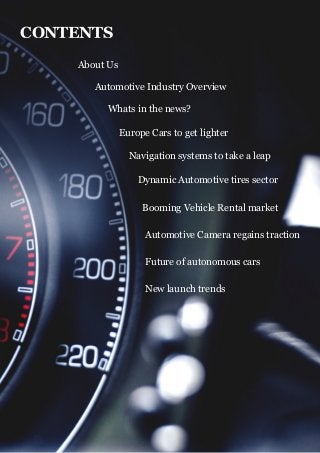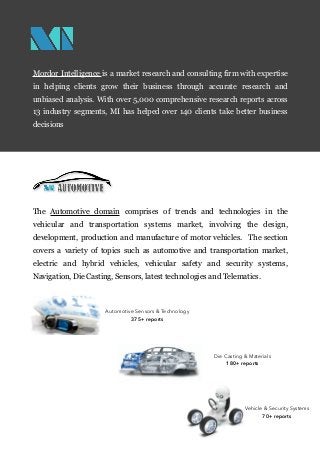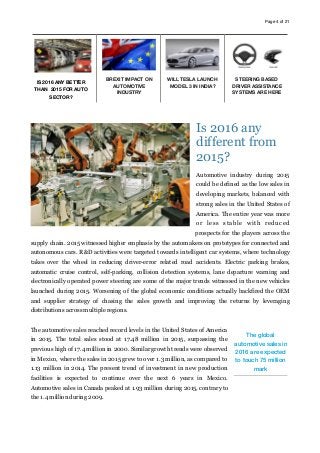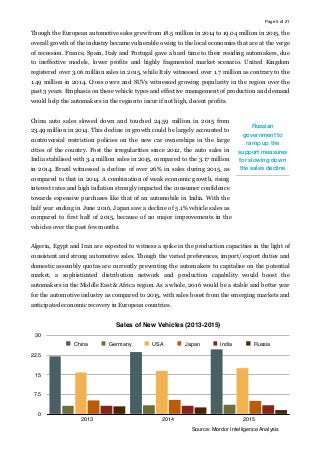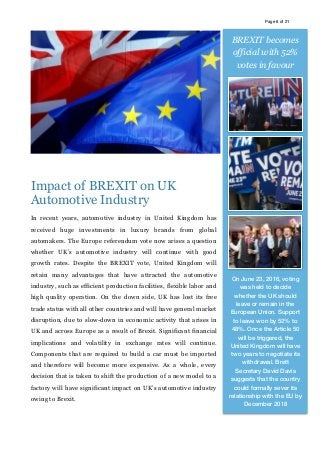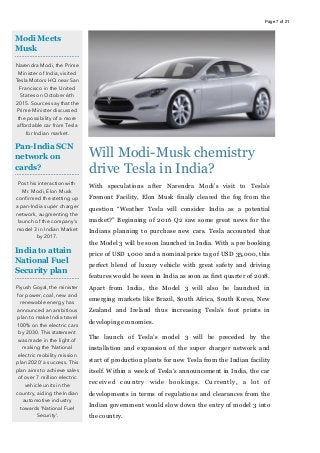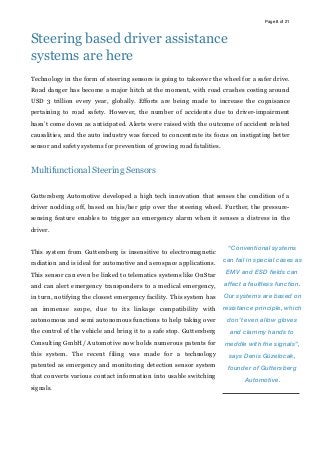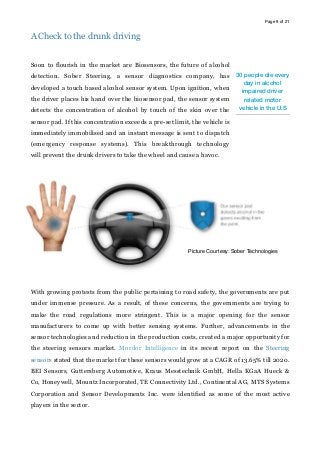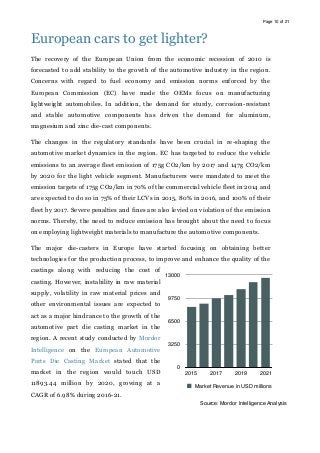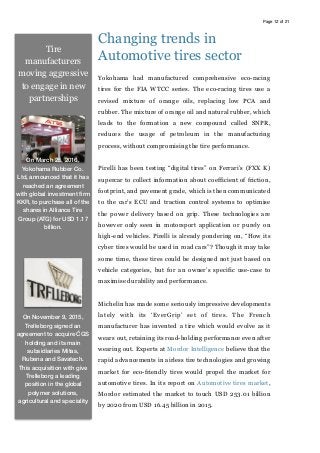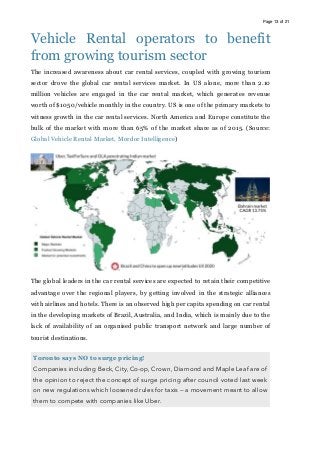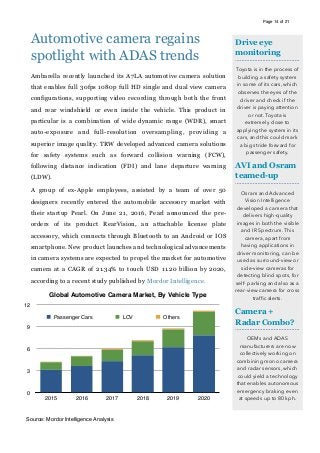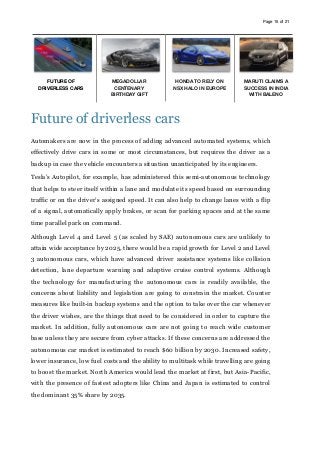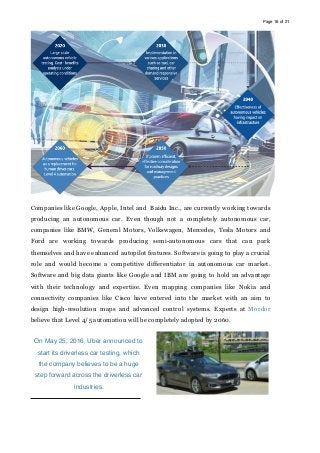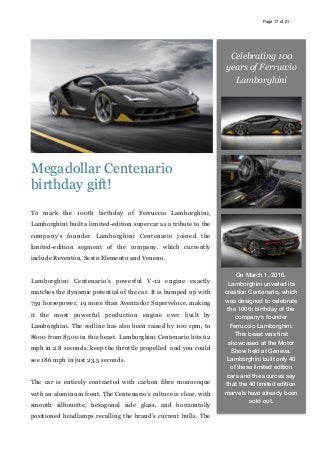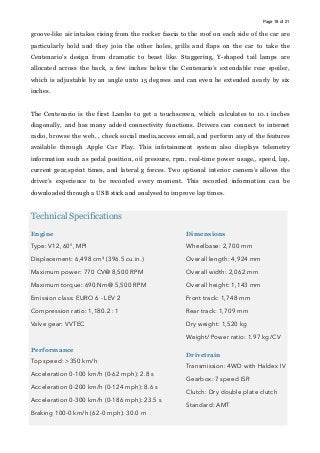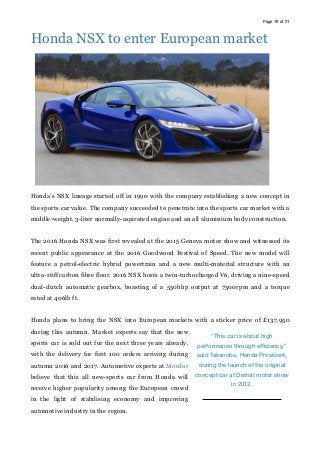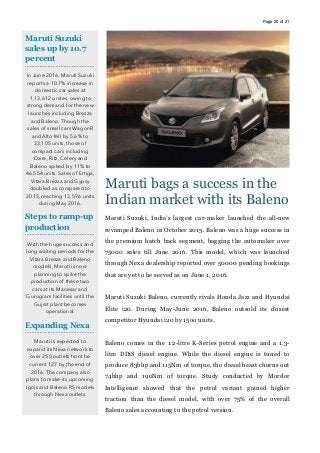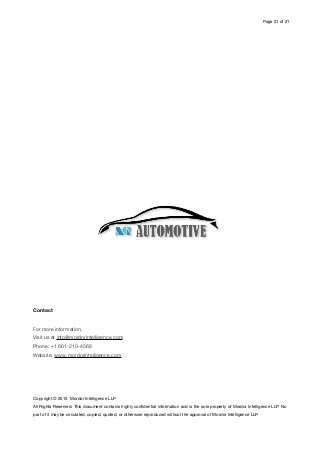Automotive Sector Monitor Q2 Issue
- 1. Page of1 21 AUTO SECTOR MONITOR 2016 Q2 Issue
- 2. Page of2 21 CONTENTS About Us Automotive Industry Overview Whats in the news? Europe Cars to get lighter Navigation systems to take a leap Dynamic Automotive tires sector Booming Vehicle Rental market Automotive Camera regains traction Future of autonomous cars New launch trends
- 3. Page of3 21 Mordor Intelligence is a market research and consulting firm with expertise in helping clients grow their business through accurate research and unbiased analysis. With over 5,000 comprehensive research reports across 13 industry segments, MI has helped over 140 clients take better business decisions The Automotive domain comprises of trends and technologies in the vehicular and transportation systems market, involving the design, development, production and manufacture of motor vehicles. The section covers a variety of topics such as automotive and transportation market, electric and hybrid vehicles, vehicular safety and security systems, Navigation, Die Casting, Sensors, latest technologies and Telematics. Automotive Sensors & Technology 375+ reports Die Casting & Materials 180+ reports Vehicle & Security Systems 70+ reports
- 4. Page of4 21 Is 2016 any different from 2015? Automotive industry during 2015 could be defined as the low sales in developing markets, balanced with strong sales in the United States of America. The entire year was more or less stable with reduced prospects for the players across the supply chain. 2015 witnessed higher emphasis by the automakers on prototypes for connected and autonomous cars. R&D activities were targeted towards intelligent car systems, where technology takes over the wheel in reducing driver-error related road accidents. Electric parking brakes, automatic cruise control, self-parking, collision detection systems, lane departure warning and electronically operated power steering are some of the major trends witnessed in the new vehicles launched during 2015. Worsening of the global economic conditions actually backfired the OEM and supplier strategy of chasing the sales growth and improving the returns by leveraging distributions across multiple regions. The automotive sales reached record levels in the United States of America in 2015. The total sales stood at 17.48 million in 2015, surpassing the previous high of 17.4 million in 2000. Similar growth trends were observed in Mexico, where the sales in 2015 grew to over 1.3 million, as compared to 1.13 million in 2014. The present trend of investment in new production facilities is expected to continue over the next 6 years in Mexico. Automotive sales in Canada peaked at 1.93 million during 2015, contrary to the 1.4 million during 2009. IS 2016 ANY BETTER THAN 2015 FOR AUTO SECTOR? BREXIT IMPACT ON AUTOMOTIVE INDUSTRY WILL TESLA LAUNCH MODEL 3 IN INDIA? STEERING BASED DRIVER ASSISTANCE SYSTEMS ARE HERE The global automotive sales in 2016 are expected to touch 75 million mark
- 5. Page of5 21 Though the European automotive sales grew from 18.5 million in 2014 to 19.04 million in 2015, the overall growth of the industry became vulnerable owing to the local economies that are at the verge of recession. France, Spain, Italy and Portugal gave a hard time to their residing automakers, due to ineffective models, lower profits and highly fragmented market scenario. United Kingdom registered over 3.06 million sales in 2015, while Italy witnessed over 1.7 million as contrary to the 1.49 million in 2014. Cross overs and SUVs witnessed growing popularity in the region over the past 3 years. Emphasis on these vehicle types and effective management of production and demand would help the automakers in the region to incur if not high, decent profits. China auto sales slowed down and touched 24.59 million in 2015 from 23.49 million in 2014. This decline in growth could be largely accounted to controversial restriction policies on the new car ownerships in the large cities of the country. Post the irregularities since 2012, the auto sales in India stabilised with 3.4 million sales in 2015, compared to the 3.17 million in 2014. Brazil witnessed a decline of over 26% in sales during 2015, as compared to that in 2014. A combination of weak economic growth, rising interest rates and high inflation strongly impacted the consumer confidence towards expensive purchases like that of an automobile in India. With the half year ending in June 2016, Japan saw a decline of 5.1% vehicle sales as compared to first half of 2015, because of no major improvements in the vehicles over the past few months. Algeria, Egypt and Iran are expected to witness a spike in the production capacities in the light of consistent and strong automotive sales. Though the varied preferences, import/ export duties and domestic assembly quotas are currently preventing the automakers to capitalise on the potential market, a sophisticated distribution network and production capability would boost the automakers in the Middle East & Africa region. As a whole, 2016 would be a stable and better year for the automotive industry as compared to 2015, with sales boost from the emerging markets and anticipated economic recovery in European countries. Sales of New Vehicles (2013-2015) 0 7.5 15 22.5 30 2013 2014 2015 China Germany USA Japan India Russia Russian government to ramp up the support measures for slowing down the sales decline Source: Mordor Intelligence Analysis
- 6. Page of6 21 Impact of BREXIT on UK Automotive Industry In recent years, automotive industry in United Kingdom has received huge investments in luxury brands from global automakers. The Europe referendum vote now arises a question whether UK’s automotive industry will continue with good growth rates. Despite the BREXIT vote, United Kingdom will retain many advantages that have attracted the automotive industry, such as efficient production facilities, flexible labor and high quality operation. On the down side, UK has lost its free trade status with all other countries and will have general market disruption, due to slow-down in economic activity that arises in UK and across Europe as a result of Brexit. Significant financial implications and volatility in exchange rates will continue. Components that are required to build a car must be imported and therefore will become more expensive. As a whole, every decision that is taken to shift the production of a new model to a factory will have significant impact on UK’s automotive industry owing to Brexit. BREXIT becomes official with 52% votes in favour On June 23, 2016, voting was held to decide whether the UK should leave or remain in the European Union. Support to leave won by 52% to 48%. Once the Article 50 will be triggered, the United Kingdom will have two years to negotiate its withdrawal. Brett Secretary David Davis suggests that the country could formally sever its relationship with the EU by December 2018
- 7. Page of7 21 Will Modi-Musk chemistry drive Tesla in India? With speculations after Narendra Modi’s visit to Tesla’s Fremont Facility, Elon Musk finally cleared the fog from the question “Weather Tesla will consider India as a potential market?” Beginning of 2016 Q2 saw some great news for the Indians planning to purchase new cars. Tesla accounted that the Model 3 will be soon launched in India. With a pre booking price of USD 1,000 and a nominal price tag of USD 35,000, this perfect blend of luxury vehicle with great safety and driving features would be seen in India as soon as first quarter of 2018. Apart from India, the Model 3 will also be launched in emerging markets like Brazil, South Africa, South Korea, New Zealand and Ireland thus increasing Tesla’s foot prints in developing economies. The launch of Tesla’s model 3 will be preceded by the installation and expansion of the super charger network and start of production plants for new Tesla from the Indian facility itself. Within a week of Tesla’s announcement in India, the car received country wide bookings. Currently, a lot of developments in terms of regulations and clearances from the Indian government would slow down the entry of model 3 into the country. Modi Meets Musk Narendra Modi, the Prime Minister of India, visited Tesla Motors HQ near San Francisco in the United States on October 6th 2015. Sources say that the Prime Minister discussed the possibility of a more affordable car from Tesla for Indian market. Pan-India SCN network on cards? Post his interaction with Mr. Modi, Elon Musk confirmed the stetting up a pan-India super charger network, augmenting the launch of the company’s model 3 in Indian Market by 2017. India to attain National Fuel Security plan Piyush Goyal, the minister for power, coal, new and renewable energy has announced an ambitious plan to make India travel 100% on the electric cars by 2030. This statement was made in the light of making the ‘National electric mobility mission plan 2020’ a success. This plan aims to achieve sales of over 7 million electric vehicle units in the country, aiding the Indian automotive industry towards ‘National Fuel Security’.
- 8. Page of8 21 Steering based driver assistance systems are here Technology in the form of steering sensors is going to takeover the wheel for a safer drive. Road danger has become a major hitch at the moment, with road crashes costing around USD 3 trillion every year, globally. Efforts are being made to increase the cognisance pertaining to road safety. However, the number of accidents due to driver-impairment hasn’t come down as anticipated. Alerts were raised with the outcome of accident related causalities, and the auto industry was forced to concentrate its focus on instigating better sensor and safety systems for prevention of growing road fatalities. Multifunctional Steering Sensors Guttersberg Automotive developed a high tech innovation that senses the condition of a driver nodding off, based on his/her grip over the steering wheel. Further, the pressure- sensing feature enables to trigger an emergency alarm when it senses a distress in the driver. This system from Guttersberg is insensitive to electromagnetic radiation and is ideal for automotive and aerospace applications. This sensor can even be linked to telematics systems like OnStar and can alert emergency transponders to a medical emergency, in turn, notifying the closest emergency facility. This system has an immense scope, due to its linkage compatibility with autonomous and semi autonomous functions to help taking over the control of the vehicle and bring it to a safe stop. Guttersberg Consulting GmbH/ Automotive now holds numerous patents for this system. The recent filing was made for a technology patented as emergency and monitoring detection sensor system that converts various contact information into usable switching signals. “Conventional systems can fail in special cases as EMV and ESD fields can affect a faultless function. Our systems are based on resistance principle, which don’t even allow gloves and clammy hands to meddle with the signals”, says Denis Güzelocak, founder of Guttersberg Automotive.
- 9. Page of9 21 A Check to the drunk driving Soon to flourish in the market are Biosensors, the future of alcohol detection. Sober Steering, a sensor diagnostics company, has developed a touch based alcohol sensor system. Upon ignition, when the driver places his hand over the biosensor pad, the sensor system detects the concentration of alcohol by touch of the skin over the sensor pad. If this concentration exceeds a pre-set limit, the vehicle is immediately immobilised and an instant message is sent to dispatch (emergency response systems). This breakthrough technology will prevent the drunk drivers to take the wheel and cause a havoc. With growing protests from the public pertaining to road safety, the governments are put under immense pressure. As a result, of these concerns, the governments are trying to make the road regulations more stringent. This is a major opening for the sensor manufacturers to come up with better sensing systems. Further, advancements in the sensor technologies and reduction in the production costs, created a major opportunity for the steering sensors market. Mordor Intelligence in its recent report on the Steering sensors stated that the market for these sensors would grow at a CAGR of 13.65% till 2020. BEI Sensors, Guttersberg Automotive, Kraus Messtechnik GmbH, Hella KGaA Hueck & Co, Honeywell, Mountz Incorporated, TE Connectivity Ltd., Continental AG, MTS Systems Corporation and Sensor Developments Inc. were identified as some of the most active players in the sector. 30 people die every day in alcohol impaired driver related motor vehicle in the U.S Picture Courtesy: Sober Technologies
- 10. Page of10 21 European cars to get lighter? The recovery of the European Union from the economic recession of 2010 is forecasted to add stability to the growth of the automotive industry in the region. Concerns with regard to fuel economy and emission norms enforced by the European Commission (EC) have made the OEMs focus on manufacturing lightweight automobiles. In addition, the demand for sturdy, corrosion-resistant and stable automotive components has driven the demand for aluminum, magnesium and zinc die-cast components. The changes in the regulatory standards have been crucial in re-shaping the automotive market dynamics in the region. EC has targeted to reduce the vehicle emissions to an average fleet emission of 175g CO2/km by 2017 and 147g CO2/km by 2020 for the light vehicle segment. Manufacturers were mandated to meet the emission targets of 175g CO2/km in 70% of the commercial vehicle fleet in 2014 and are expected to do so in 75% of their LCVs in 2015, 80% in 2016, and 100% of their fleet by 2017. Severe penalties and fines are also levied on violation of the emission norms. Thereby, the need to reduce emission has brought about the need to focus on employing lightweight materials to manufacture the automotive components. The major die-casters in Europe have started focusing on obtaining better technologies for the production process, to improve and enhance the quality of the castings along with reducing the cost of casting. However, instability in raw material supply, volatility in raw material prices and other environmental issues are expected to act as a major hindrance to the growth of the automotive part die casting market in the region. A recent study conducted by Mordor Intelligence on the European Automotive Parts Die Casting Market stated that the market in the region would touch USD 11893.44 million by 2020, growing at a CAGR of 6.98% during 2016-21. 0 3250 6500 9750 13000 2015 2017 2019 2021 Market Revenue in USD millions Source: Mordor Intelligence Analysis
- 11. Page of11 21 Augmented Reality to shape-shift the auto navigation experience Jaguar Land Rover (JLR) has been working on reality- augmentation technology for off- roading and track driving, which the company has now introduced into urban commute. In order to make the manoeuvring through urban traffic less hazardous, the company has developed a “360 Virtual Urban Windscreen” that employs “transparent pillars” in order to eliminate blind spots. JLR, by employing external cameras and embedding screens in the windscreen, is now trying to provide the natural image from the same angle. Continental is working on its new AR HUD prototype installed in a Kia K9 sedan, in Germany. The new augmented reality complements the car’s existing HUD, which shows information of media selection, speed and basic navigation instructions. This new technology is believed to add extra layer of dynamic information to the existing HUD based navigation system. WayRay, a Swiss based startup, has recently introduced an augmented reality navigation system that actually projects holographic GPS imagery and notifications onto the windshield of the car. Navion, the first of its kind “holographic navigation system for cars”, which is placed on the car dashboard, projects a virtual route onto the regular focal range of the driver. Experts at Mordor Intelligence forecast that the aggressive innovations from navigation system manufacturers such as WayRay and Continental would augment the automotive navigation systems market to touch USD 16.01 billion by 2021, growing at a CAGR of 7.76%. 14% 39% 47% Hardware Software Connectivity Source: Mordor Intelligence Analysis
- 12. Page of12 21 Changing trends in Automotive tires sector Yokohama had manufactured comprehensive eco-racing tires for the FIA WTCC series. The eco-racing tires use a revised mixture of orange oils, replacing low PCA and rubber. The mixture of orange oil and natural rubber, which leads to the formation a new compound called SNPR, reduces the usage of petroleum in the manufacturing process, without compromising the tire performance. Pirelli has been testing “digital tires” on Ferrari’s (FXX K) supercar to collect information about coefficient of friction, footprint, and pavement grade, which is then communicated to the car’s ECU and traction control systems to optimise the power delivery based on grip. These technologies are however only seen in motorsport application or purely on high-end vehicles. Pirelli is already pondering on, “How its cyber tires would be used in road cars”? Though it may take some time, these tires could be designed not just based on vehicle categories, but for an owner’s specific use-case to maximise durability and performance. Michelin has made some seriously impressive developments lately with its ‘EverGrip’ set of tires. The French manufacturer has invented a tire which would evolve as it wears out, retaining its road-holding performance even after wearing out. Experts at Mordor Intelligence believe that the rapid advancements in airless tire technologies and growing market for eco-friendly tires would propel the market for automotive tires. In its report on Automotive tires market, Mordor estimated the market to touch USD 253.01 billion by 2020 from USD 16.45 billion in 2015. Tire manufacturers moving aggressive to engage in new partnerships On March 25, 2016, Yokohama Rubber Co. Ltd, announced that it has reached an agreement with global investment firm KKR, to purchase all of the shares in Alliance Tire Group (ATG) for USD 1.17 billion. On November 9, 2015, Trelleborg signed an agreement to acquire ČGS holding and its main subsidiaries Mitas, Rubena and Savatech. This acquisition with give Trelleborg a leading position in the global polymer solutions, agricultural and speciality
- 13. Page of13 21 Vehicle Rental operators to benefit from growing tourism sector The increased awareness about car rental services, coupled with growing tourism sector drove the global car rental services market. In US alone, more than 2.10 million vehicles are engaged in the car rental market, which generates revenue worth of $1050/vehicle monthly in the country. US is one of the primary markets to witness growth in the car rental services. North America and Europe constitute the bulk of the market with more than 65% of the market share as of 2015. (Source: Global Vehicle Rental Market, Mordor Intelligence) The global leaders in the car rental services are expected to retain their competitive advantage over the regional players, by getting involved in the strategic alliances with airlines and hotels. There is an observed high per capita spending on car rental in the developing markets of Brazil, Australia, and India, which is mainly due to the lack of availability of an organised public transport network and large number of tourist destinations. Toronto says NO to surge pricing! Companies including Beck, City, Co-op, Crown, Diamond and Maple Leaf are of the opinion to reject the concept of surge pricing after council voted last week on new regulations which loosened rules for taxis — a movement meant to allow them to compete with companies like Uber.
- 14. Page of14 21 Automotive camera regains spotlight with ADAS trends Ambarella recently launched its A7LA automotive camera solution that enables full 30fps 1080p full HD single and dual view camera configurations, supporting video recording through both the front and rear windshield or even inside the vehicle. This product in particular is a combination of wide dynamic range (WDR), smart auto-exposure and full-resolution oversampling, providing a superior image quality. TRW developed advanced camera solutions for safety systems such as forward collision warning (FCW), following distance indication (FDI) and lane departure warning (LDW). A group of ex-Apple employees, assisted by a team of over 50 designers recently entered the automobile accessory market with their startup Pearl. On June 21, 2016, Pearl announced the pre- orders of its product RearVision, an attachable license plate accessory, which connects through Bluetooth to an Android or IOS smartphone. New product launches and technological advancements in camera systems are expected to propel the market for automotive camera at a CAGR of 21.34% to touch USD 11.20 billion by 2020, according to a recent study published by Mordor Intelligence. Drive eye monitoring Toyota is in the process of building a safety system in some of its cars, which observes the eyes of the driver and check if the driver is paying attention or not. Toyota is extremely close to applying the system in its cars, and this could mark a big stride forward for passenger safety. AVI and Osram teamed-up Osram and Advanced Vision Intelligence developed a camera that delivers high-quality images in both the visible and IR Spectrum. This camera, apart from having applications in driver monitoring, can be used as surround-view or side-view cameras for detecting blind spots, for self- parking and also as a rear-view camera for cross traffic alerts. Camera + Radar Combo? OEMs and ADAS manufacturers are now collectively working on combining mono camera and radar sensors, which could yield a technology that enables autonomous emergency braking even at speeds up to 80 kph. Global Automotive Camera Market, By Vehicle Type 0 3 6 9 12 2015 2016 2017 2018 2019 2020 Passenger Cars LCV Others Source: Mordor Intelligence Analysis
- 15. Page of15 21 Future of driverless cars Automakers are now in the process of adding advanced automated systems, which effectively drive cars in some or most circumstances, but requires the driver as a backup in case the vehicle encounters a situation unanticipated by its engineers. Tesla’s Autopilot, for example, has administered this semi-autonomous technology that helps to steer itself within a lane and modulate its speed based on surrounding traffic or on the driver’s assigned speed. It can also help to change lanes with a flip of a signal, automatically apply brakes, or scan for parking spaces and at the same time parallel park on command. Although Level 4 and Level 5 (as scaled by SAE) autonomous cars are unlikely to attain wide acceptance by 2025, there would be a rapid growth for Level 2 and Level 3 autonomous cars, which have advanced driver assistance systems like collision detection, lane departure warning and adaptive cruise control systems. Although the technology for manufacturing the autonomous cars is readily available, the concerns about liability and legislation are going to constrain the market. Counter measures like built-in backup systems and the option to take over the car whenever the driver wishes, are the things that need to be considered in order to capture the market. In addition, fully autonomous cars are not going to reach wide customer base unless they are secure from cyber attacks. If these concerns are addressed the autonomous car market is estimated to reach $60 billion by 2030. Increased safety, lower insurance, low fuel costs and the ability to multitask while travelling are going to boost the market. North America would lead the market at first, but Asia-Pacific, with the presence of fastest adopters like China and Japan is estimated to control the dominant 35% share by 2035. FUTURE OF DRIVERLESS CARS MEGADOLLAR CENTENARY BIRTHDAY GIFT HONDA TO RELY ON NSX HALO IN EUROPE MARUTI CLAIMS A SUCCESS IN INDIA WITH BALENO
- 16. Page of16 21 Companies like Google, Apple, Intel and Baidu Inc., are currently working towards producing an autonomous car. Even though not a completely autonomous car, companies like BMW, General Motors, Volkswagen, Mercedes, Tesla Motors and Ford are working towards producing semi-autonomous cars that can park themselves and have enhanced autopilot features. Software is going to play a crucial role and would become a competitive differentiator in autonomous car market. Software and big data giants like Google and IBM are going to hold an advantage with their technology and expertise. Even mapping companies like Nokia and connectivity companies like Cisco have entered into the market with an aim to design high-resolution maps and advanced control systems. Experts at Mordor believe that Level 4/5 automation will be completely adopted by 2060. On May 25, 2016, Uber announced to start its driverless car testing, which the company believes to be a huge step forward across the driverless car industries.
- 17. Page of17 21 Megadollar Centenario birthday gift! To mark the 100th birthday of Ferruccio Lamborghini, Lamborghini built a limited-edition supercar as a tribute to the company’s founder Lamborghini Centenario joined the limited-edition segment of the company, which currently include Reventón, Sesto Elemento and Veneno. Lamborghini Centenario’s powerful V-12 engine exactly matches the dynamic potential of the car. It is bumped up with 759 horsepower, 19 more than Aventador Superveloce, making it the most powerful production engine ever built by Lamborghini. The redline has also been raised by 100 rpm, to 8600 from 8500 in this beast. Lamborghini Centenario hits 62 mph in 2.8 seconds; keep the throttle propelled and you could see 186 mph in just 23.5 seconds. The car is entirely contracted with carbon fibre monocoque with an aluminum front. The Centenario’s culture is clear, with smooth silhouette, hexagonal side glass, and horizontally positioned headlamps recalling the brand’s current bulls. The Celebrating 100 years of Ferruccio Lamborghini On March 1, 2016, Lamborghini unveiled its creation Centenario, which was designed to celebrate the 100th birthday of the company’s founder Ferruccio Lamborghini. This beast was first showcased at the Motor Show held at Geneva. Lamborghini built only 40 of these limited edition cars and the sources say that the 40 limited edition marvels have already been sold out.
- 18. Page of18 21 groove-like air intakes rising from the rocker fascia to the roof on each side of the car are particularly bold and they join the other holes, grills and flaps on the car to take the Centenario’s design from dramatic to beast like. Staggering, Y-shaped tail lamps are allocated across the back, a few inches below the Centenario’s extendable rear spoiler, which is adjustable by an angle unto 15 degrees and can even be extended nearly by six inches. The Centenario is the first Lambo to get a touchscreen, which calculates to 10.1 inches diagonally, and has many added connectivity functions. Drivers can connect to internet radio, browse the web, , check social media,access email, and perform any of the features available through Apple Car Play. This infotainment system also displays telemetry information such as pedal position, oil pressure, rpm, real-time power usage,, speed, lap, current gear,sprint times, and lateral g forces. Two optional interior camera’s allows the driver’s experience to be recorded every moment. This recorded information can be downloaded through a USB stick and analysed to improve lap times. Technical Specifications Engine Type: V12, 60°, MPI Displacement: 6,498 cm³ (396.5 cu.in.) Maximum power: 770 CV@ 8,500 RPM Maximum torque: 690 Nm@ 5,500 RPM Emission class: EURO 6 - LEV 2 Compression ratio: 1,180.2 : 1 Valve gear: VVTEC Performance Top speed: >350 km/h Acceleration 0-100 km/h (0-62 mph): 2.8 s Acceleration 0-200 km/h (0-124 mph): 8.6 s Acceleration 0-300 km/h (0-186 mph): 23.5 s Braking 100-0 km/h (62-0 mph): 30.0 m Dimensions Wheelbase: 2,700 mm Overall length: 4,924 mm Overall width: 2,062 mm Overall height: 1,143 mm Front track: 1,748 mm Rear track: 1,709 mm Dry weight: 1,520 kg Weight/ Power ratio: 1.97 kg/CV Drivetrain Transmission: 4WD with Haldex IV Gearbox: 7 speed ISR Clutch: Dry double plate clutch Standard: AMT
- 19. Page of19 21 Honda NSX to enter European market Honda’s NSX lineage started off in 1990 with the company establishing a new concept in the sports car value. The company succeeded to penetrate into the sports car market with a middle-weight, 3-liter normally-aspirated engine and an all aluminium body construction. The 2016 Honda NSX was first revealed at the 2015 Geneva motor show and witnessed its recent public appearance at the 2016 Goodwood Festival of Speed. The new model will feature a petrol-electric hybrid powertrain and a new multi-material structure with an ultra-stiff carbon fibre floor. 2016 NSX hosts a twin-turbocharged V6, driving a nine-speed dual-clutch automatic gearbox, boasting of a 550bhp output at 7500rpm and a torque rated at 406lb ft. Honda plans to bring the NSX into European markets with a sticker price of £137,950 during this autumn. Market experts say that the new sports car is sold out for the next three years already, with the delivery for first 100 orders arriving during autumn 2016 and 2017. Automotive experts at Mordor believe that this all new-sports car from Honda will receive higher popularity among the European crowd in the light of stabilising economy and improving automotive industry in the region. “This car is about high performance through efficiency,” said Takanobu, Honda President, during the launch of the original concept car at Detroit motor show in 2012.
- 20. Page of20 21 Maruti bags a success in the Indian market with its Baleno Maruti Suzuki, India’s largest car-maker launched the all-new revamped Baleno in October 2015. Baleno was a huge success in the premium hatch back segment, bagging the automaker over 75000 sales till June 2016. This model, which was launched through Nexa dealership reported over 50000 pending bookings that are yet to be served as on June 1, 2016. Maruti Suzuki Baleno, currently rivals Honda Jazz and Hyundai Elite i20. During May-June 2016, Baleno outsold its closest competitor Hyundai i20 by 15oo units. Baleno comes in the 1.2-litre K-Series petrol engine and a 1.3- litre DDiS diesel engine. While the diesel engine is tuned to produce 83bhp and 115Nm of torque, the diesel beast churns out 74bhp and 190Nm of torque. Study conducted by Mordor Intelligence showed that the petrol variant gained higher traction than the diesel model, with over 75% of the overall Baleno sales accounting to the petrol version. Maruti Suzuki sales up by 10.7 percent In June 2016, Maruti Suzuki reports a 10.7% increase in domestic car sales at 1,13,612 unites, owing to strong demand for the new launches including Brezza and Baleno. Though the sales of small cars WagonR and Alto fell by 5.6% to 33,105 units, those of compact cars including Dzire, Ritz, Celery and Baleno spiked by 11% to 46.554 units. Sales of Ertiga, Vitara Brezza and Gypsy doubled as compared to 2015, reaching 13,596 units during May 2016. Steps to ramp-up production With the huge success and long waiting periods for the Vitara Brezza and Baleno models, Maruti is now planning to spike the production of these two cars at its Manesar and Gurugram facilities until the Gujrat plant becomes operational. Expanding Nexa Maruti is expected to expand its Nexa network to over 250 outlets front he current 127 by the end of 2016. The company also plans to make its upcoming Ignis and Baleno RS models through Nexa outlets.
- 21. Page of21 21 Copyright © 2015 Mordor Intelligence LLP All Rights Reserved. This document contains highly confidential information and is the sole property of Mordor Intelligence LLP. No part of it may be circulated, copied, quoted, or otherwise reproduced without the approval of Mordor Intelligence LLP. Contact For more information, Visit us at info@mordorintelligence.com Phone: +1 661-210-4568 Website: www.mordorintelligence.com

